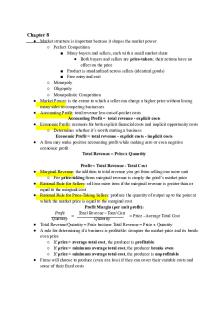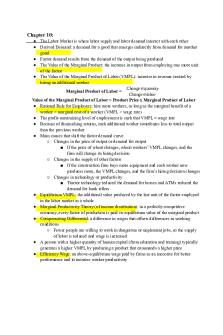Econ chapter 151 - Lecture notes 21 PDF

| Title | Econ chapter 151 - Lecture notes 21 |
|---|---|
| Author | Anonymous User |
| Course | Econometrics |
| Institution | San Diego State University |
| Pages | 29 |
| File Size | 2.1 MB |
| File Type | |
| Total Downloads | 33 |
| Total Views | 137 |
Summary
Prado Lopez lecture notes from chapter 16...
Description
E=rcon Chapter 15 What are the business cycles? •
Real GDP over the long run Grows about 3% per year on average
• •
GDP in the short run Fluctuates around its trend
• • • • •
Recessions Periods of falling real incomes and rising unemployment Depressions Severe recessions (very rare)
FACT 1: Economic fluctuations are irregular and unpredictable FACT 2: Most macroeconomic quantities fluctuate together. FACT 3: As output falls, unemployment rises.
*Price level will MOVE not SHIFT*
ANSWERS ^:
A: Decreases investment.... shift to the left in aggregate demand B: NX rises, shift to the right in aggregate demand curve
C: aggregate demand curve does not change... move down along aggregate demand curve (wealth effect) D: Consumption rises, aggregate demand curve shifts right
Clicker: e
The natural rate of output (YN) is the amount of output the economy produces when unemployment is at its natural rate, also called potential output or full employment output
Clicker #2:
For example, the sticky-wage theory asserts that output prices adjust more quickly to changes in the price level than wages do, in part because of long-term wage contracts. Suppose a firm signs a contract agreeing to pay its workers $15 per hour for the next year, based on an expected price level of 100. If the actual price level turns out to be 110, the firm's output prices willrise , and the wages the firm pays its workers will remain fixed at the contracted level. The firm will respond to the unexpected increase in the price level byincreasing the quantity of output it supplies. If many firms face similarly rigid wage contracts, the unexpected increase in the price level causes the quantity of output supplied torise above the natural level of output in the short run. According to the sticky-wage theory, the short-run aggregate supply curve slopes upward because nominal wages are slow to adjust to economic conditions. If the
!
price level turns out to be higher than what firms and workers anticipated when they negotiated wage contracts, output prices will rise even as wages remain fixed at the agreed-upon level. As firms see their output prices rise faster than their input prices, their profits rise, which gives them an incentive to increase production. Conversely, if the price level is unexpectedly low, firms will see their output prices fall below expected levels with no change in their labor costs. They will respond by reducing output.
• Wages only sticky in short run • Prices will be corrected...
• When price level is expected, the rate will be at its natural level of output^
• When price expectations rises (workers expecting higher wages), higher wages will be set • Clicker:
Y= Yn + a (P-Pe) P= Pe Y=Yn
• Goes from A to B to C ^
Conclusion:
Classical Dicatomy ^
Point where economy is not growing (output not increasing), but prices are rising = stagflation ^
Policy^- From point B to A
When Analyzing macroeconomic changes, follow these four steps: 1. Decide whether the event shifts the aggregate demand curve or the aggregate supply curve 2. Decide the direction in which the curve shifts 3. Use the diagram of aggregate demand and aggregate supply to determine the impact on output and the price level in the short run 4. Use the diagram of aggregate demand and aggregate supply to analyze how the economy moves from it’s new short run equilibrium to its new long run equilibrium
•
According to the sticky wage theory, the short run aggregate supply curve slopes upward because nominal wages are based on expected prices and do not respond immediately when the actual price level turns out to be different than expected
•
When the price level is above the expected price level, workers will eventually demand higher nominal wages to compensate for the higher price level
When the short run aggregate supply curve shifts left, that will increase the price level and reduce output resulting in a situation sometimes called stagflation.
•
The wealth effect: A lower price level raises the real value of households’ money holdings, which are part of their wealth. Higher
real wealth stimulates consumer spending and thus increases the quantity of goods and services demanded. •
The interest-rate effect: A lower price level reduces the amount of money people want to hold. As people try to lend out their excess money holdings, the interest rate falls. The lower interest rate stimulates investment spending and thus increases the quantity of goods and services demanded.
•
The exchange-rate effect: When a lower price level reduces the interest rate, investors move some of their funds overseas in search of higher returns. This movement of funds causes the real value of the domestic currency to fall in the market for foreign-currency exchange. Domestic goods become less expensive relative to foreign goods. This change in the real exchange rate stimulates spending on net exports and thus increases the quantity of goods and services demanded.
Aggregate demand: C+I+G+NX •
Moves along aggregate demand: due to a change in price level
•
A change in the price level results in a change of quantity of goods and services demanded
•
Any other change will be a shift along the curve
Why the aggregate demand has a downward slope: -wealth effect -exchange rate effect -interest rate effect
Interest rates go mostly with investment -When interest rates are high, its more expensive to invest
-As interest rates goes up, investment goes down -As interest rates goes down, investment goes up Appreciation: when the dollar gains value... 1 U.S. dollar can buy you more Euros... 1 Euro can buy less U.S dollars
•
NX= exports-imports
•
Exports will go down, imports will go up when the U.S. dollar appreciates... net exports will go down
•
When price expectations change, shifts SRAS...
Similar Free PDFs

Econ chapter 151 - Lecture notes 21
- 29 Pages

ECON-21 - Lecture notes 1-10
- 8 Pages

151 - Lecture notes 1
- 23 Pages

ECON 104 Lecture Notes
- 21 Pages

ECON 1001 Lecture Notes
- 156 Pages

Lesson 21 - Lecture notes 21
- 31 Pages
Popular Institutions
- Tinajero National High School - Annex
- Politeknik Caltex Riau
- Yokohama City University
- SGT University
- University of Al-Qadisiyah
- Divine Word College of Vigan
- Techniek College Rotterdam
- Universidade de Santiago
- Universiti Teknologi MARA Cawangan Johor Kampus Pasir Gudang
- Poltekkes Kemenkes Yogyakarta
- Baguio City National High School
- Colegio san marcos
- preparatoria uno
- Centro de Bachillerato Tecnológico Industrial y de Servicios No. 107
- Dalian Maritime University
- Quang Trung Secondary School
- Colegio Tecnológico en Informática
- Corporación Regional de Educación Superior
- Grupo CEDVA
- Dar Al Uloom University
- Centro de Estudios Preuniversitarios de la Universidad Nacional de Ingeniería
- 上智大学
- Aakash International School, Nuna Majara
- San Felipe Neri Catholic School
- Kang Chiao International School - New Taipei City
- Misamis Occidental National High School
- Institución Educativa Escuela Normal Juan Ladrilleros
- Kolehiyo ng Pantukan
- Batanes State College
- Instituto Continental
- Sekolah Menengah Kejuruan Kesehatan Kaltara (Tarakan)
- Colegio de La Inmaculada Concepcion - Cebu









